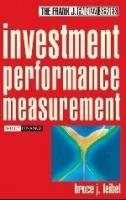
After we have set out the objectives for an investment, considered the challenges to reaching them, developed a strategy with the optimal chance of
meeting our goals, allocated assets to asset classes and managers, and purchased the securities to build our portfolios, the next step is to check the
results. Investment performance measurement is the quantification of the
results achieved by an investment program. This book describes and demonstrates the techniques we use to measure investment performance. Performance measures are statistics summarizing the rates of return achieved, estimates of the risk taken, and measures of the skill evidenced by the efficient use of risk. Once we have measured performance we are interested in measuring the contributions made by the securities, industries, asset classes, and other portfolio segments to the absolute and benchmark relative returns achieved.
Together the returns and the insight gained as to how the returns were attained help foster the next round of asset allocation, manager selection, and security selection decisions. These decisions form a recurring investment cycle as the process starts again with the insight gained from the historical analysis, reevaluation of our future needs, and evaluation of the prospective opportunities.
Whether we are in the role of individual or institutional investor, delegate our investment decision making to others, or responsible for managing the portfolios, we are all interested in weighing the results of our activities. Historical risk and return statistics help form our expectations for future expected risk and return that we use in the process of constructing efficient portfolios. As investors, our goals for capital growth, income, and liquidity have to be synchronized with the realities presented by the capital markets, our abilities to select good managers, and the manager’s ability to produce excess returns over time.
As part of a performance evaluation we compare the results we achieved to those earned by others with similar goals and constraints. We compare the performance of the managers we selected to managers with similar philosophies. Peer and benchmark relative performance are important to the investment manager. Investment managers are hired based in part on their relative past performance. As investment managers, the actual performance of our strategy provides insight into our strengths and helps adjust strategy for facing the future.
Performance measurement is an exciting and dynamic topic whose importance grows along with the increasing sophistication of investors and the strategies that they employ. The field lies at the nexus of the academic and the practical. Practitioners use ideas developed in the fields of finance, statistics, and accounting and blend them together with the realities presented by the cost of performing the analysis, data availability, technology, and, increasingly, tax and regulatory considerations to produce a meaningful analysis. Investors put a great deal of time and energy into the calculation, presentation, and interpretation of investment performance results. This commitment of resources and the serious consequences of the conclusions derived from performance results warrant a thorough examination of the subject.
Performance measurement is an important component of the body of knowledge for anyone involved in investing. This book provides someone who is interested in the topic with two things: A comprehensive and integrated survey of each of the steps taken to measure performance as well as a guide to the calculation, meaning, and interpretation of the various risk and return statistics commonly encountered by anyone responsible for selecting, monitoring, and evaluating the performance of investment managers. A reference to the calculation and presentation of historical risk and return statistics, detailed enough to be of use to practitioners charged with carrying out the analysis. In the illustrations that are used to explain the various concepts presented in the book, a spreadsheet format is used so that it is easier for the reader to replicate the calculations.
By reviewing both the concepts of performance measurement as well as
examples of how they are used, we gain the insight necessary to understand
and evaluate the management of investment funds. Although these sections provide worked examples illustrating particular techniques for analyzing performance, there is an important qualification accompanying these examples: we do not mean to imply that the methodology presented here is the only way to go about it. Many of the statistics in this book can be calculated in different ways.
This is especially true in the areas of risk measurement and performance
attribution. There are also multiple definitions for some of the statistics of
performance measurement. For example, practitioners use the term “alpha” in several different ways. We do not attempt here to inventory every variation in performance measurement methodology. Instead, we present fully worked examples representing a mainstream approach to implementing the major concepts in order to provide the reader with a hands-on experience in computing and applying the measures. There are many possible refinements to the examples presented here to meet the needs of a particular situation. The dynamic nature of the investments field and the creativity of its participants ensure that there will be a continuous stream of innovations in the measurement of performance.
| Прикрепленный файл | Размер |
|---|---|
| Investment_Performance_Measurement.zip | 3.68 Мб |

